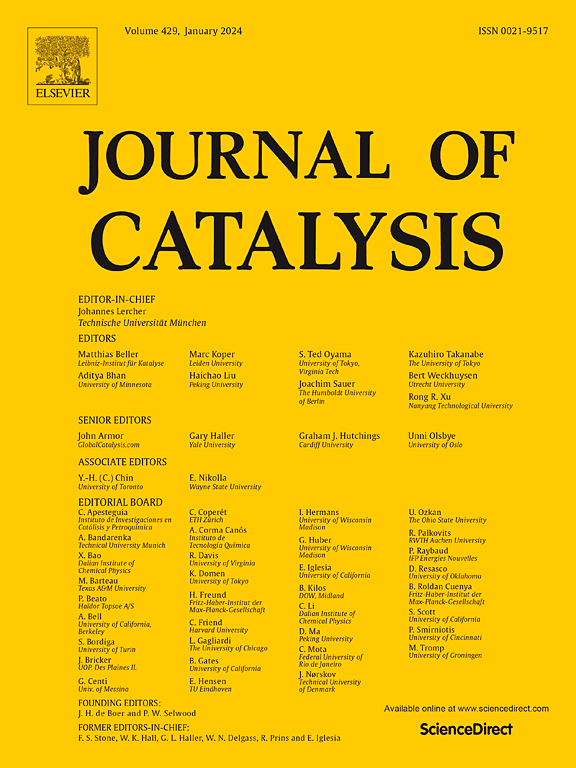First-principles, data-guided screening and catalyst design: Unveiling energetic trade-offs in ammonia decomposition
IF 6.5
1区 化学
Q2 CHEMISTRY, PHYSICAL
引用次数: 0
Abstract
Ammonia decomposition is a promising route for CO2-free hydrogen production, but the development of efficient and cost-effective catalysts remains a challenge. Here, we employed a dual approach combining computational screening and free energy analysis to identify optimal catalysts, which were then validated experimentally. Pearson correlation coefficient analysis revealed a volcano-type relationship between NH3 dissociation energy (Ediss,NH3) and N2 adsorption energy (Ead,N2), highlighting Ru as the most effective monometallic catalyst. Reactor tests using supported Ru, Rh, Ir, Ni, and Co catalysts confirmed these predictions, with Ru exhibiting the highest NH3 conversion and a strong correlation between turnover frequency, activation energy (Ea), and electronic descriptors. Using this validated approach, we extended our analysis to bimetallic systems, identifying Ru-Ni alloys, as a promising alternative with balanced NH3 activation and N2 desorption. These findings demonstrate the effectiveness of combining computational and experimental methods to design high-performance NH3 decomposition catalysts. Further refinement of Ru-Ni alloy synthesis and structural control could enhance catalytic activity, supporting scalable hydrogen production.

第一原理,数据指导筛选和催化剂设计:揭示氨分解的能量权衡
氨分解是一种很有前途的无二氧化碳制氢途径,但开发高效、经济的催化剂仍然是一个挑战。本文采用计算筛选和自由能分析相结合的双重方法来确定最佳催化剂,并进行了实验验证。Pearson相关系数分析显示,NH3解离能(Ediss,NH3)与N2吸附能(Ead,N2)呈火山型关系,表明Ru是最有效的单金属催化剂。使用Ru, Rh, Ir, Ni和Co催化剂的反应器测试证实了这些预测,Ru表现出最高的NH3转化率,并且在周转频率,活化能(Ea)和电子描述符之间具有很强的相关性。使用这种经过验证的方法,我们将分析扩展到双金属体系,确定了Ru-Ni合金作为平衡NH3活化和N2脱附的有前途的替代品。这些发现证明了计算方法和实验方法相结合设计高性能NH3分解催化剂的有效性。进一步改进Ru-Ni合金的合成和结构控制可以提高催化活性,支持规模化制氢。
本文章由计算机程序翻译,如有差异,请以英文原文为准。
求助全文
约1分钟内获得全文
求助全文
来源期刊

Journal of Catalysis
工程技术-工程:化工
CiteScore
12.30
自引率
5.50%
发文量
447
审稿时长
31 days
期刊介绍:
The Journal of Catalysis publishes scholarly articles on both heterogeneous and homogeneous catalysis, covering a wide range of chemical transformations. These include various types of catalysis, such as those mediated by photons, plasmons, and electrons. The focus of the studies is to understand the relationship between catalytic function and the underlying chemical properties of surfaces and metal complexes.
The articles in the journal offer innovative concepts and explore the synthesis and kinetics of inorganic solids and homogeneous complexes. Furthermore, they discuss spectroscopic techniques for characterizing catalysts, investigate the interaction of probes and reacting species with catalysts, and employ theoretical methods.
The research presented in the journal should have direct relevance to the field of catalytic processes, addressing either fundamental aspects or applications of catalysis.
 求助内容:
求助内容: 应助结果提醒方式:
应助结果提醒方式:


